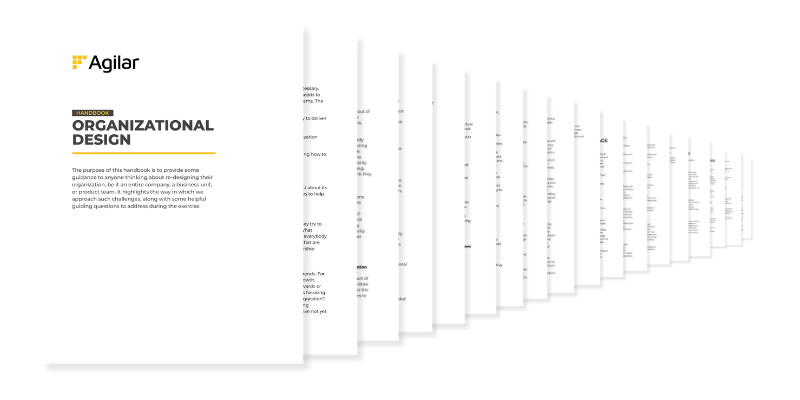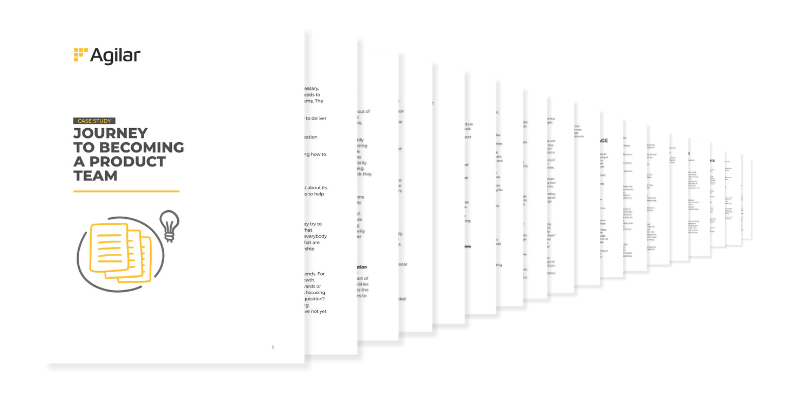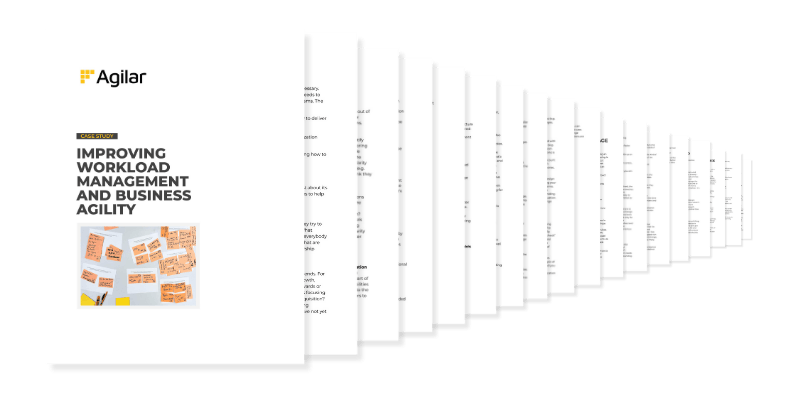

Designing Organizations & Operating Models
We simplify your organization, removing unnecessary structures and allowing for greater organizational flexibility.
We design custom operating models, increasing business agility with context-specific approaches.
We guide you through the transition, from small, multi-team environments up to organization-wide change initiatives.


Discover how to get started with creating a more adaptable organization with our handbook “Designing organizations and operating model”.
Download it for free and get started today.
Typical challenges we solve
Overly complex structures
Mis-aligned teams, unnecessary hierarchies, or lack of end-to-end collaboration focused on value delivery.
Inefficient processes
Excessive bureaucracy, slow decision making, or redundant meetings that slow down value delivery and flexibility.
Unclear roles & responsibilities
Dependant teams with unclear working agreements, lack of ownership, and excessive handovers.
Scaling value delivery
Need to scale up without losing flexibility, rigid operating models, staying aligned at scale.
“Agilar was a key partner in our Agile transformation - their experience in scaling, organizational design, and change management was invaluable in helping us deal with the challenges of changing our organization and improving our agility.”

Sergii Martyshko
Agile Transformation Lead Europe, ABInBev
Why companies choose to work with us
Customized approach
Instead of framework-led change, we prefer to first align on context and then co-create custom operating models with a pattern-led approach (the patterns you need to solve your specific problems).

20+ years of experience
Guiding clients in their change initiatives, and understanding what it takes to create structures and operating models that help improve value delivery.
Aligned with strategy
The goal is not “to be Agile”, but rather to succeed in your market place. We start by understanding the vision and strategy, and then co-create the structures and processes needed to enable those key strategic capabilities.
Sustainable solutions
There is no such thing as the “perfect organizational design”, rather the key to success is to build in the routines and practices necessary to enable organizations to continuously reflect on structure and processes, and adapt what's not working.

Discover how to get started with creating a more adaptable organization with our handbook “Designing organizations and operating model”.
Download it for free and get started today.
Case Studies

Journey to becoming a product team
A real-life case study of how Tracked Mail transformed their ways of working with Scrum. From struggling teams to a high-performing Agile culture that delivers consistently.
Go to Case Study
Transforming a company with OKRs
Struggling with rigid planning and silos, a multinational FMCG company turned to OKRs to boost agility and alignment. See how they tackled governance challenges, embraced cultural shifts, and balanced global strategy with regional needs. Watch the video and download the case study.
Go to Case Study
Improving workload management and business agility
A global enterprise with 30,000 employees faced key challenges in their Global Business Excellence team—misalignments, work overload, and lack of visibility. Discover how we helped them streamline processes and drive success.
Go to Case StudyFor leaders who want to improve their organization
Typical roles interested in this topic
Change Leads, responsible for improving structure and ways of working.
Product Managers and Agile Coaches, responsible for designing flexible, collaborative, multi-team environments.
Organizational leaders, responsible for organizational culture and structure.
HR / People Teams, responsible for supporting the learning & development of people working in Agile environments.
Related Tools
Companion
Our own change management tool, it supports the assessment of teams/tribes, tracking of key improvement KPIs or goals, and visualizing the overall status of the change initiative. This transparency supports the effective management of change/improvement activities, ensuring they deliver impact.
Try it for free
Why do our clients continue to work with us?
Pragmatism & flexibility
We understand the importance of theory and frameworks and we understand there is no such thing as the “perfect solution”. Context matters and change momentum can only be sustained with clear early wins. So we focus on co-creating structures and operating models that align the change ambitions with the willingness to change. And by having a change approach that incorporates clear objectives and KPIs, we reflect frequently with clients on progress being made, and adapt wherever necessary.

Change management expertise
We believe the biggest reason change initiatives fail is not because of lack of leadership support, resistance to change, or lack of budget. We believe change fails mostly because of lack of good change management. Our approach combines the Kotter model with our experience in defining leading and lagging indicators that enable our clients to track the impact the change is having on the business. This leads to focused change initiatives able to adapt along the way to ensure positive outcomes.

Broad industry experience
We have extensive experience in a broad range of vertical industries, such as Fast Moving Consumer Goods (FMCG), Finance & Insurance, Telco, Gaming, and Manufacturing. We are also pioneers in taking agility beyond product / software teams and into the domain of business or operational teams.

Related Articles you may be interested in
Tiago Garcez
28 Mar, 2025
3 key questions for organizational design
This guide starts with three questions to shape your operating model: What is your product, how do you manage BAU, and do you need two layers of governance? It offers practical ways to structure teams, balance ongoing work, and align governance.
Go to ArticleNicolás Chirio
19 Feb, 2025
What are OKRs and why the hype?
Ever feel like your work isn’t making an impact? Or that priorities keep shifting without clear direction? OKRs (Objectives and Key Results) might be the solution.
Go to ArticleNicolás Chirio
24 Feb, 2025
How to make OKRs work for you
Struggling with shifting priorities, low engagement, and lack of transparency? OKRs can help—but only if implemented effectively. In this article, I break down the key steps to making OKRs your new goal-setting standard.
Go to ArticleNicolás Chirio
05 Mar, 2025
Overcoming challenges when implementing OKRs
Implementing Objectives and Key Results (OKRs) in your organization is a great step toward aligning teams and improving performance. However, despite having a structured checklist, many teams encounter challenges along the way. Let’s explore some of the most common issues and how to overcome them effectively.
Go to ArticleGet in touch!
Let's discuss your needs, we’re eager to listen! Fill out our form below and we will get back to you as soon as possible.